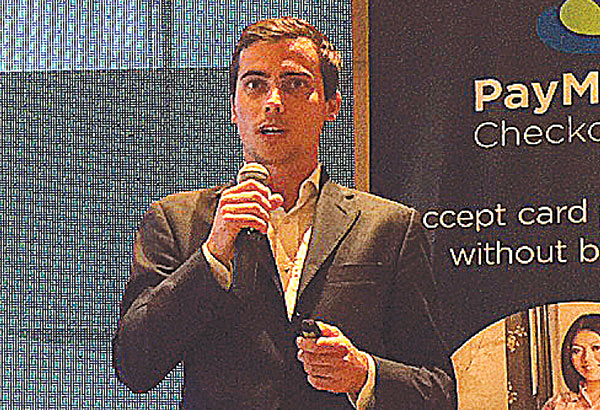Online payment gateway for merchants seen to push local e-commerce growth

MANILA, Philippines – Soon, your friendly neighborhood store or favorite mom and pop shop may be able to accept credit or debit card payments.
PayMaya Philippines, the digital financial services arm of PLDT and Smart Communications and a unit of Voyager Innovations, recently launched PayMaya Checkout, a payment gateway facility that will allow businesses – even small and medium enterprises (SMEs) and startups – to accept card payments in their websites and mobile apps.
Paolo Azzola, co-COO and managing director of PayMaya Philippines, says there are about a million merchants around the Philippines and anyone who requires acceptance of payments online would be able to sign up for the service.

The process for setting up a payment facility should not be a painful experience for online merchants or even for brick and mortar stores, says PayMaya Philippines co-COO and managing director Paolo Azzola.
“We have large merchants like Philippine Airlines and small merchants like startups, so we have a solution that is tailored to any merchant regardless of the size,” he says.
For online payments, Checkout comes with an application programmer interface (API) that is easy to integrate in websites or apps. The package also comes with a dashboard of transaction reports for sales performance tracking.
For face-to-face transactions or card present transactions, Azzola says the PayMaya Touch mobile Point of Sale (mPOS) will be deployed to establishments that may need them. Touch, he says, is fully compliant with the EMV chip-card authentication standard that will be required soon by the Bangko Sentral ng Pilipinas for card transactions.
E-Commerce Opportunity Growing
Why should enterprises, small or large, be selling online? Mitch Padua, Voyager Innovations’ vice president and managing director for digital commerce, says business-to-consumer (B2C) e-commerce is a $2-trillion opportunity worldwide and probably the top competitive proposition for merchants to take their businesses online.
“By 2020, it would double to around $4 trillion,” he says. “That represents about 15 percent of total retail sales worldwide.”
In Southeast Asia, Padua says the total retail market today, according to a Google-Temasek study, is about $786 billion, but the online retail market stands only at around $14 billion, or just 1.8 percent of the market. The figure is, however, forecast to grow exponentially.
The same study projects B2C e-commerce to grow from $14 billion to $88 billion by 2025 in Southeast Asia, which will be driven by internet penetration, consumer sentiment, and product availability.
In the Philippines, 54 percent of the country’s population of over 110 million is already online.
“While consumers are already online, enterprises are still lagging behind,” Padua says. “If you are not selling today online, you are not part of these numbers.”
He adds that a study also shows that for every consumer visit to a brick and mortar store, the same consumer will actually visit an online store 41 times. This means that merchants will have 41 times chance to sell to that one consumer.
“Today, in our pockets, we actually have entire storefronts and you can actually transact online, face-to-face, with a mobile phone or a tablet,” he says.
Locally, retailers may be in an advantageous position as the number of Filipinos with access to the internet is projected to reach 77 million by 2019, and 66 percent will have smartphones.
Online Payment Facility
Obviously, payment is at the heart of an e-commerce experience, but is it what Filipino customers really want?
Citing a MasterCard study, Azzola says more than half of customers globally will buy more if a particular merchant accepts card payment.
“That trend is coming to the Philippines for now and until the next three years,” he says. “But first, there are certain issues that need to be addressed. First, transaction cost has traditionally been elevated. Secondly, the settlement is quite long for most merchants. And finally, this technology has been traditionally very difficult to implement in the past.”
This, he says, is the reason why the current ratio is 500 cards for one POS system in the Philippines, compared to 40-to-one in developed markets. The cash on delivery market is also extremely high (80 percent) for local online transactions, compared to 34 percent in other Asia-Pacific markets.
Azzola stressed that the process for setting up a payment facility should not be a painful experience for online merchants anymore or even for brick and mortar stores. It shouldn’t require very high fees either.
PayMaya promises easy integrating, competitive pricing and fast settlement.
“The requirements are very simple. For small merchants, it’s usually the business permit from the Department of Trade and Industry, for larger merchants Security and Exchange Commission registration an bank statements, but we make it a lot less stringent than other boundaries of compliance with the Bangko Sentral,” Azzola says.
The service is already available and merchants can sign up right now. In fact, there are already live merchants on PayMaya Checkout such as the Philippine Airlines online boutique store and the online gadget store, Kimstore.
“The solution itself has various degrees of complexity or various degrees of services based on what the merchant needs. If it is a merchant that just requires very simple card acceptance, that is extremely easy and quick to implement. If it is a merchant that requires sophisticated solutions, which the larger merchants usually need, then we are happy to provide those,” Azzola says.
The current process is semi-automatic in terms of onboarding. However, by the beginning of next year, Azzola says Checkout will have a fully self-assisted onboarding process.
- Latest




























